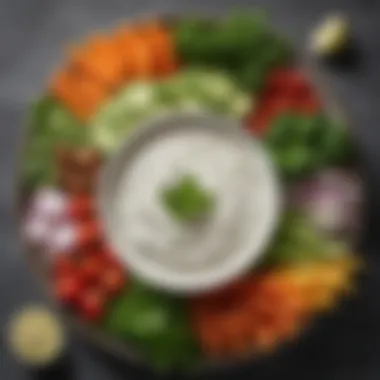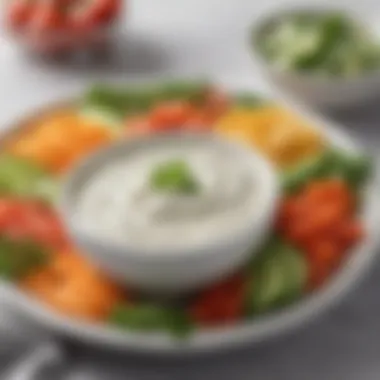Crafting the Ultimate Ranch Dip for Vegetables


Intro
Creating the perfect ranch dip for vegetables isn’t just about mixing a few ingredients in a bowl. It's an art form that requires a measure of creativity, a dash of culinary science, and a genuine passion for flavors that dance on the palate. Ranch dip, with its creamy texture and zesty undertones, offers an irresistible allure, especially when paired with crunchy veggies. Let’s roll up our sleeves and dive into the intricacies of this beloved dip that transforms any gathering into a culinary celebration.
In this guide, we unravel the secrets behind crafting an exceptional ranch dip. We will examine key ingredients, explore variations that cater to different tastes, and delve into practical methods that elevate your dip game. Along the way, we’ll give you tips not just for preparing this dip but for making it a centerpiece for both casual snacking and sophisticated events.
Whether you’re a seasoned home cook or just a busy individual looking to simplify meal prep, understanding the foundations of an outstanding ranch dip can enhance your kitchen skills and enrich your culinary experience. Prepare yourself to impress family and friends with a dip that’s bursting with flavor and personality.
Prelude to Ranch Dip
Ranch dip has earned its spot as a go-to accompaniment, particularly when it comes to vegetables. Whether you’re reeling in friends for game night or hosting an elegant get-together, this dip brings a comforting familiarity to any gathering. It offers a balance of flavors that elevates ordinary snacks into something more substantial. In the world of appetizers, ranch dip surely holds its own, not just as a sidekick but as a star in its own right.
While ranch dressing originally started out as a salad dressing, it has evolved into a versatile dip that many people now associate with the joy of dipping—and let’s face it, few things are more satisfying than crunching into a fresh vegetable that’s been dunked in a creamy, herby concoction. This introduction doesn’t merely pay homage to the dip itself; it lays the groundwork for understanding its origins, its critical components, and what contributes to an exceptional ranch dip.
Origins of Ranch Dressing
The tale of ranch dressing dates back to the 1950s, sparked by a cowboy named Steve Henson. He created this flavorful blend while working as a contractor in Alaska and later moved to California with his wife, Gayle. They opened a ranch in the Santa Barbara area, known as Hidden Valley Ranch, where they served the now iconic dressing to guests. The recipe, originally made with buttermilk, mayonnaise, and a mix of herbs, quickly became a hit, garnering a loyal following. It didn’t take long for ranch dressing to jump off the ranch and into the bottles of supermarkets across the country.
Today, ranch dressing seems to be everywhere—from salads to pizza, and of course, as a dip for vegetables. Its widespread popularity can be attributed to its adaptability, making it a staple not just in American kitchens but also in cultural cuisine.
"Ranch dressing is more than just a flavor; it's a reflection of shared experiences at tables, picnics, and parties."
What Defines a Great Ranch Dip
A great ranch dip isn’t just about slapping some ranch dressing on a plate and calling it a day. No, it involves a careful blending of the right ingredients, ensuring a perfect harmony of taste and texture. Here’s what sets a standout ranch dip apart:
- Balance of Creaminess: The dip should coax your taste buds without overwhelming them. Having the right blend of sour cream and mayonnaise, or even buttermilk, creates a delectable creamy texture.
- Freshness of Herbs: Fresh herbs like dill and chives can transform an average ranch dip into something extraordinary. These ingredients not only add flavor but also bring a vibrant color to the dish.
- A Hint of Acid: A splash of lemon juice or vinegar can elevate the dip. This acidity cuts through the richness, creating a more complex and enjoyable taste.
- Customization: A great ranch dip can be modified to cater to personal preferences. From spicy enhancements of jalapeños to vegan alternatives, a dip that keeps evolving is more appealing than ever.
The true test of any ranch dip lies in its ability to complement the fresh vegetables it accompanies. A dip that’s too thick can overshadow the delicate flavor of carrots and cucumbers, while one that’s too runny may leave the veggies adrift in a watery pool. Finding the sweet spot is essential for creating a dip that truly shines.
Essential Ingredients for Ranch Dip
The backbone of any successful ranch dip lies in the selection of its ingredients. Understanding these essential components can transform a simple mixture into a flavor-packed companion for your fresh vegetables. The right balance of textures and tastes is essential to achieving that smooth, creamy dip everyone has come to know and love. Each ingredient brings its unique quality to the table, making it pivotal to get them right.
Base Ingredients
Sour Cream
Sour cream is often regarded as the workhorse of ranch dip. Its thick and creamy texture is key to creating that luscious mouthfeel that pairs so well with crisp veggies. Sour cream adds a tangy flavor profile, which is essential in achieving that classic ranch taste. One of its main benefits is its richness—it blends beautifully with herbs and spices without becoming overwhelming.
However, one must take heed. For those looking to cut calories or dietary fat, sour cream can be a bit heavy on the waistline. Fortunately, there are lighter versions available, which still manage to retain a lot of that signature taste.
Mayonnaise
Mayonnaise brings a silky smoothness that complements the sour cream without overshadowing it. With its oil content, it helps to emulsify the dip, creating a richer texture. Its flavor is less tangy than sour cream and can add a subtle sweetness, giving a well-rounded flavor to the dip.
While many people find mayonnaise a must-have in their dip recipes, those watching their cholesterol might prefer to use a light or fat-free version. This substitution still provides that creamy consistency without the added guilt.
Buttermilk
Buttermilk adds a distinctively tangy taste, making it a hero in many homemade ranch dips. Its thinner consistency, compared to sour cream and mayonnaise, lends a lighter body to the dip, which some people prefer. Additionally, buttermilk is often seen as a healthier alternative because it's lower in calories than its creamier counterparts.
One downside to buttermilk, however, is its more ephemeral shelf life. Once opened, it needs to be consumed relatively quickly, which may not suit everyone’s cooking habits.
Herbs and Spices
Dill
Dill is an unsung hero in ranch dip, bringing a unique herbaceous note that cuts through the creaminess. Its bright flavor profile works in harmony with the dip's richness, creating a zesty balance. Dill’s popularity in ranch recipes comes from its versatility—it pairs well with both fresh and dried forms, making it a staple in most kitchens.
On the flip side, some people may find dill's flavor overwhelming if they use too much. It’s best to start with a smaller quantity and slowly adjust to personal taste.
Chives
Chives are fantastic for a mild onion flavor, providing a subtle bite without overwhelming the delicate balance of ranch dip. Their vibrant green color adds an aesthetic touch, making the final dish visually appealing. Chives are easy to use, requiring only a simple chop before incorporation.
The one thing to watch for is its short shelf life. Fresh chives need to be used or stored properly, or they can wilt and lose their flavor quickly.
Garlic Powder
A dash of garlic powder can drastically elevate your ranch dip. It adds an earthy note that enhances the overall flavor without the pungency of fresh garlic. Its convenience is a huge plus—powder doesn’t require prep work, and it has a long shelf life, making it a great pantry staple.


However, overdoing it can lead to an overpowering taste, so moderation is key.
Onion Powder
Onion powder is another versatile component that contributes an essential depth of flavor. It provides a rounded, smooth oniony taste that blends perfectly into the creamy base. Like garlic powder, it's easy to use and can be found in almost any kitchen.
The downside? If you’re aiming for a fresh taste, onion powder lacks the aromatic qualities of fresh onions. The depth may feel flat if you are accustomed to the sharper notes that come with the real deal.
Acid Component
Lemon Juice
Lemon juice serves not just as a tangy addition but also as a balancing agent that brightens up the overall flavor of the ranch dip. It cuts through the richness and adds a refreshing sharpness. Its acidity helps enhance the flavors of the other ingredients, making this a necessary component in your dip.
Nonetheless, it’s easy to go overboard. Too much lemon juice can make the dip taste more like a citrus salad than ranch, so keep a cautious hand when measuring.
Vinegar Options
Different vinegars can also provide that necessary acidity. White vinegar or apple cider vinegar can add varying degrees of tanginess to your ranch dip. Vinegar brings depth and complexity along with that brightness, creating a harmonious flavor.
However, vinegar can be quite potent, and a heavy hand might lead to an unpalatable sour dip. It’s important to taste as you go, ensuring the flavor remains balanced.
In crafting the perfect ranch dip for vegetables, each ingredient plays a vital role in creating a satisfying experience that pleases the palate. Tailoring your ingredient choices based on flavor preferences and dietary needs can lead to countless delightful variations.
Preparation Techniques
When it comes to crafting a delightful ranch dip, understanding preparation techniques is the bedrock of achieving that creamy texture and flavor punch. These methods not only influence the final taste but also determine the overall experience of enjoying the dip. From the mixing stages to the important chilling processes, each technique plays a vital role, ensuring that the ingredients meld harmoniously. Mastering these preparation techniques can elevate a simple ranch dip into a crowd-pleasing phenomenon.
Mixing Methods
The mixing methods lay the foundation for how well the ingredients integrate and ultimately how smooth or textured the dip turns out. There are two prominent techniques often utilized: whisking and blending.
Whisking
Whisking stands out as a popular choice among home cooks due to its simplicity and effectiveness. This method involves using a whisk, incorporating air into the mixture, which lightens the texture. It’s fantastic for combining the base ingredients like sour cream and mayonnaise, giving the dip a fluffy personality.
A key characteristic of whisking is its ability to create an emulsion, which is crucial for ranch dip; it binds oil with the other components. Another big plus is it allows one to easily gauge texture and consistency during the process. The downside? Well, if you're mixing in larger quantities, it can get a bit tiresome on the wrist.
Blending
On the flip side, blending often wields a different kind of dynamism in the kitchen. Using something like an immersion blender or countertop blender effortlessly creates a creamy and uniform ranch dip. The consistency achieved here is as smooth as silk, making it a favorite for those who dislike any hint of lumpiness in their dip.
The key characteristic of blending is its speed and sheer efficiency. You can throw in all your ingredients at once and let the machine do the work in a matter of seconds. However, some purists argue that blending lacks the hands-on feel of whisking, robbing it of a certain rustic charm.
Chilling and Resting
After mixing comes the all-important stage of chilling and resting. This interval is often overlooked, but it holds critical significance in flavor development and texture refinement. Allowing your dip to sit in the fridge gives the flavors time to sit and meld together, creating a richer taste.
Why Chilling is Crucial
Chilling is crucial because it helps the flavors intensify while allowing any herbs or spices to permeate the base. Imagine pulling out that dip after it has been resting; the scent alone can steer anyone towards the snack table! The cool temperature also has a delightful effect, making every bite refreshing and palatable, especially alongside crisp veggies.
One unique aspect of this technique is the role it plays in food safety. Keeping the dip cold not only enhances flavor but also helps in maintaining freshness, prolonging its shelf life if stored correctly. However, if left too long outside after mixing, the dip may spoil, so it's always best to serve it chilled.
Recommended Chilling Time
So how long should you let your ranch dip chill? Generally, a good guideline is to allow it to rest in the fridge for at least two hours. This duration tends to hit the sweet spot where flavors have adequately blended without sacrificing texture. Think of this time as the dip soaking up all the best bits from the herbs and spices, amplifying the taste.
Chilling too short a time can lead to a dip that's far too sharp or lacking in cohesion. Conversely, longer chilling might dry it out a bit or make it overly thick. Aim for that perfect balance; a well-timed chilling phase ensures each bite is as flavorful as it can get.
"Chilling is often the unsung hero in food prep; without it, tastes can just fall flat."
By understanding and applying these preparation techniques, you're not just making a ranch dip; you're creating a crowd-pleaser, a statement on your snack table that begs to be revisited. Whether you're mixing, whisking, chilling, or resting, these processes all converge to create a heavenly ranch dip that complements any vegetable platter. Start experimenting and find your winning combination!
Exploring Variations of Ranch Dip
Crafting a great ranch dip is like painting on a blank canvas—there's room for creativity. Exploring the variations of ranch dip allows cooks to tailor the flavor profile to fit different palates or occasions. Adding your personal touch can turn a simple dip into a sensational star at parties, picnics, or weeknight dinners. Each variation not only enhances the traditional taste but also opens doors to different culinary experiences.
Spicy Ranch Dip
Incorporating Hot Sauce
When it comes to teasing out flavors, hot sauce plays a significant role in the ranch dip arena. Adding just a splash of your favorite hot sauce, like Frank’s RedHot or Cholula, can introduce a delightful kick that elevates the dip from ordinary to extraordinary. The unique characteristic of hot sauce is its heat, which balances beautifully with the creamy base of the ranch. This is a popular choice for those who crave a bit of fiery pep in their appetizers. However, you should consider using hot sauces with flavors that complement, not overshadow, the herbs and spices already in the dip.


Using Jalapeños
Jalapeños add another dimension of flavor and crunch to ranch dip. Slicing fresh jalapeños into fine pieces can provide both heat and texture, which enhances the mouthfeel of each bite. The versatility of jalapeños—fresh, pickled, or even roasted—offers multiple options to explore. This option appeals to many because it taps into the fresh, vibrant taste of the pepper. Yet, caution is wise: the level of spiciness can vary significantly, so adjusting the amount according to your taste or that of your guests is essential.
Herbed Ranch Dip
Fresh Herbs vs. Dried
One crucial decision while crafting a herbed ranch dip is choosing between fresh or dried herbs. Fresh herbs like dill and chives bring vibrant color and an intense aromatic quality that can enhance the dip considerably. They impart a refreshing quality, making your dip seem lively when served alongside vegetables. On the other hand, dried herbs offer convenience and longevity; they don’t require any prep. However, their potency can sometimes come off as less pronounced compared to their fresh counterparts. It’s a tug of war between convenience and vibrancy, and picking the right option often hinges on what you have at hand and the occasion.
Regional Variations
Ranch dip isn’t a monolith; different regions might put their own spin in it. For instance, in the South, some folks might prefer adding bacon or barbecue sauce, bringing unique flavors to the mix. Others in the Southwest might infuse it with lime and cilantro for a zesty twist. These regional variations not only celebrate local tastes but offer an opportunity to explore new combinations that can delight the palate. While trying to concoct something new, it's key to ensure the variations still carry the essence of ranch, keeping it familiar yet exciting.
Vegan Ranch Dip
Plant-Based Alternatives
With more folks leaning towards plant-based diets, plant-based alternatives make ranch dip accessible to vegans. Options like cashew cream, coconut yogurt, or almond-based sour cream provide a creamy base that mimics the traditional dip without using any dairy. The beauty of using plant-based alternatives lies in their adaptability; you can customize flavors to suit your taste preferences while keeping it wholly vegan. This is beneficial for those with dietary restrictions or anyone looking to dabble in healthier alternatives. Nonetheless, some may find the taste difference significant compared to classic ranch, so experimenting might be needed.
Nut-Free Options
Nut-free alternatives are essential for those with nut allergies. Utilizing products like sunflower seed butter or pea protein yogurt can help create a creamy texture without dairy or nuts. These ingredients are great choices, making the dip accessible to a broader audience. The challenge here is retaining that creamy mouthfeel and robust flavor that ranch dip is loved for. If executed well, nut-free options can be just as satisfying as traditional ranch dips, enabling everyone to enjoy delicious snacks without worry.
By embracing variations of ranch dip, you're not just following a recipe; you're embarking on a culinary adventure that could lead you to discover flavors you never thought you’d enjoy.
Pairing Ranch Dip with Vegetables
Pairing ranch dip with vegetables is more than just a matter of taste; it’s an art form. The right vegetable not only enhances the flavor of the ranch dip but also elevates the entire snacking experience. The crunch of fresh veggies mixed with the creamy, herby notes of the dip invites you to dig in.
In this section, we will delve into optimal vegetable choices and presentation techniques. We'll explore the reasons behind selecting specific vegetables that complement the dip's flavor profile and the aesthetic ways to serve them. Ultimately, these choices contribute to both the enjoyment of the dish itself and the way it fits into social settings, whether it's a casual get-together or a more formal gathering.
Optimal Vegetable Choices
Crunchy Vegetables
When it comes to crunch, vegetables such as celery, carrots, and bell peppers reign supreme. Their defining characteristic is their satisfying snap when bitten into, making them perfect companions for ranch dip. Crunchy vegetables provide a refreshing contrast to the creaminess of the dip, creating a delightful textural interplay.
These vegetables are also easy to prepare. Simply wash, peel, and chop them into manageable sticks or bite-sized pieces. Furthermore, they stand out for their visual appeal—the bright colors and varied shapes lend vibrancy to any platter. A significant advantage of crunchy vegetables is that they are nutrient-dense, offering fiber along with vitamins that not only complement health but also enhance the eating experience.
However, it’s worth noting that some people might find certain crunchy veggies like raw onions or radishes to be sharp or overwhelming in flavor. Balancing them carefully with the dip ensures that you maintain a palate-pleasing experience.
Colorful Mixes
To really make your ranch dip shine, think about colorful mixes. Vegetables like cherry tomatoes, radishes, and even purple cauliflower can add splashes of brightness to your serving tray. The unique feature of colorful vegetables is their ability to draw attention and create visual interest, which is important in social situations.
The contrast in colors can not only make the dish more inviting but also hints at the various flavors waiting to be explored. Each color usually signifies different nutrients, which can encourage guests to indulge without guilt.
However, with this approach, moderation is key. Too much variety may lead to overwhelming flavor combinations. Choosing a few standout colors ensures that you keep the focus on the ranch dip while enhancing the overall gastronomic experience.
Presentation Techniques
Serving Platters
A well-chosen serving platter can transform your presentation from mundane to magnificent. The importance of using a visually appealing platter is paramount, as it acts as the canvas for showcasing your vegetables and dip.
Opting for a unique dish—perhaps one with a rustic look or bright design—can subtly enhance the experience, drawing your guests’ eyes and increasing their appetite. Furthermore, using sections or compartments can neatly organize the vegetables, allowing for easy access and creating a layout that invites guests to partake at their leisure.
The downside? A large, extravagant platter might overshadow the simplicity of the veggies and ranch dip. Balance is key; ensure that the focus remains on what’s being served without the vessel becoming a distraction.
Garnishing Tips
Garnishing is an often-overlooked aspect of serving and can elevate your ranch dip to new heights. Sprinkling some fresh herbs on top of the dip not only adds a pop of color but also ties back into the flavors already present in the dip.
Ingredients like freshly chopped dill or chives can enhance presentation while emphasizing the herby undertones of the ranch dip. A light drizzle of olive oil over the top may also provide a sleek finish.
However, be cautious with garnishes; excessive decor can make the dish feel cluttered and detract from the main elements. A little goes a long way, and a thoughtful garnish can make the difference between an everyday snack and a gourmet experience.
Pairing ranch dip with thoughtfully selected vegetables and clever presentation techniques not only pleases the palate but also creates an inviting atmosphere for any gathering.
Nutritional Considerations


In today's culinary landscape, being mindful of nutritional considerations is crucial, especially when enjoying dishes like ranch dip. This section will unpack the elements that contribute to not just taste, but also the overall health profile of this beloved dip. Understanding the balance between flavor and nutrition is key to elevating your ranch dip game without compromising on health.
Caloric Content Analysis
When indulging in ranch dip, it’s important to know what you’re putting on your plate. A standard serving of ranch dip typically contains around 70 to 100 calories per two tablespoons. This might not seem like much, but it can add up quickly, particularly at a party or buffet where you find yourself going back for one more scoop. For instance, if you’re dipping carrots or celery sticks, the vegetable’s inherent low calorie content means you could be consuming more than you think when paired with a rich dip.
Here’s a breakdown of common caloric counts for some popular ingredients used in ranch dip:
- Sour Cream: Approximately 60 calories per tablespoon.
- Mayonnaise: About 90 calories per tablespoon, depending on whether it's the regular or light version.
- Buttermilk: Roughly 25 calories per tablespoon.
Considering these numbers helps when you’re trying to maintain a balanced diet. If you're conscious about calorie intake, moderation is essential. You might find it useful to measure out portions or keep track of how much dip you’re serving at a gathering.
Healthier Ingredient Swaps
If you’re looking for better options without sacrificing the taste you love, swap out some ingredients for healthier alternatives. You don't have to say goodbye to your favorite dip; simply opt for a few smarter choices. Here are suggestions that can lighten up your ranch dip:
- Greek Yogurt Instead of Sour Cream: Using plain Greek yogurt not only reduces calories but also increases protein, making your dip more satisfying.
- Light Mayonnaise: This can cut calories down significantly, allowing you to enjoy a creamy texture without the guilt.
- Nut Milk for Buttermilk: If you’re seeking a dairy-free option, non-dairy milk alternatives, like almond or oat milk, can work as a substitute, especially if you add a splash of vinegar or lemon juice to mimic buttermilk’s tanginess.
- Fresh Herbs: Switch from dried herbs to fresh ones. Not only do fresh herbs offer superior flavor, they also come with extra nutrients that can enhance the nutritional profile of your ranch dip.
In the quest for creating the ultimate ranch dip, balancing health with taste is a dance of culinary finesse.
A little thought about what goes into your dish can make a world of difference in how you feel after enjoying it.
Being conscious about ingredients doesn’t mean you have to sacrifice flavor. Instead, you can tailor the ranch dip to fit a healthier lifestyle while fulfilling those taste bud cravings. It’s all about experimenting and finding the right balance that works for you.
Storing and Serving Ranch Dip
Storing and serving ranch dip properly is key to maintaining its flavor and freshness. Ranch dip is a versatile companion for a variety of vegetables, and when treated right, it can keep your gatherings and snacking simple yet delicious. The way you store the dip can affect its taste and texture, which is something that any discerning cook should take to heart.
Storage Guidelines
Refrigeration Duration
When it comes to refrigeration, ranch dip typically remains fresh for about three to four days. This timeframe is crucial as it helps retain the dip's creamy texture and the vibrant flavors from the herbs and spices. If it's kept longer than that, you might start noticing a shift in taste and possibly even spoilage.
The greatness of this duration is that it caters to busy lifestyles. You can whip up a batch on Sunday and enjoy it throughout the week without the fear of it going off too quickly. It's a good idea to store it in an airtight container to keep it safe from other strong odors in the fridge. Think of your leftovers! While ranch dip is generally popular in many homes, the key characteristic lies in its relatively short lifespan compared to other dips. If it starts to develop an off smell, it's best to toss it out.
Freezing Tips
Freezing ranch dip is a bit of a double-edged sword. While it is possible to freeze it for extended storage, it can alter the dip’s original creamy texture once thawed. For short-term solutions, consider freezing in ice cube trays. Each cube can later be mixed with fresh ingredients to revive its freshness, allowing you to create smaller portions for on-the-go snacks.
Freezing can extend the dip's life up to a couple of months, making it a viable option for meal prep and emergencies. Just keep in mind that upon thawing, the consistency might become a tad grainy or watery. If you don't mind a little extra tweaking, such as stirring in a bit of sour cream or mayonnaise after thawing, this could be a clever choice for those who enjoy prolonged access to their favorite dip.
Serving Suggestions
At Buffets
When it comes to serving ranch dip at buffets, presentation is a significant factor. Using a sturdy bowl and making sure it’s filled generously can provide a warm welcome to any platter of fresh vegetables. The characteristic of ranch dip at a buffet lies in its appeal. Sure, it's a classic choice, but it also invites guests to experiment with flavors by dipping a variety of crunchy delights.
Consider adding a few mixed herbs or a sprinkle of paprika on the top for that touch of elegance. This adds a visual appeal that might catch the eye of guests. The advantage is that ranch dip is often loved by all ages, making it a safe bet for large gatherings. While some may be hesitant about exploring other dips, ranch tends to draw people in, balancing familiarity and flavor.
During Gatherings
Serving ranch dip during gatherings—whether at a game day or a cozy family night—can elevate the experience. It offers not just a tasty option but also a social element as people gather around for shared enjoyment. The beauty of ranch dip during such occasions is its versatility, allowing for various pairings—whether it's crisp vegetables, chips, or even breadsticks.
The dip brings a certain warmth, helping break the ice as guests mingle. A key feature to keep in mind is the temperature at which it’s served; keeping it cool and fresh during the event will ensure its taste remains intact. A slight disadvantage, though, is that homemade ranch dip may need to be replenished more frequently than store-bought versions, especially at larger gatherings.
"The best gatherings are those centered around sharing food. With ranch dip, you do just that—providing something familiar yet infinitely customizable."
In summary, how you store and serve ranch dip greatly influences its reception in your culinary endeavors. Proper storage ensures you savor its flavors longer while thoughtful serving techniques create an inviting atmosphere that enhances any event.
The End
The conclusion wraps up all the pieces that have been laid out throughout this guide, emphasizing why mastering ranch dip is not just a culinary task but an enjoyable journey into flavor and creativity. Without a doubt, ranch dip stands as a beloved companion to veggies, and understanding how it comes together can enhance your cooking repertoire tremendously.
Recap of Key Points
- Key Ingredients: The base ingredients of sour cream, mayonnaise, and buttermilk are crucial for achieving that creamy texture. Don't overlook the importance of fresh herbs and quality spices which bring life to the dip.
- Preparation Techniques: Mixing methods like whisking and blending are essential. Chilling the dip properly allows the flavors to meld together, ensuring a tasty outcome.
- Varieties and Pairings: Spicy versions and vegan alternatives cater to diverse taste preferences. Pairing the dip with an array of colorful vegetables elevates both the dish and presentation.
- Nutrition and Storage: An understanding of caloric content and healthier ingredient swaps can empower you to make choices that align with your dietary goals.
These points collectively highlight the journey from basic ranch dip to a more personalized version that just might become a staple at your table.
Encouragement for Experimentation
Here’s the bottom line – don’t feel boxed in by the traditional ranch recipe. The joy of cooking comes from creativity and personal touch. Try adding a splash of something new: perhaps a hint of smoked paprika for depth or even some crumbled feta for a tangy twist. You could explore using various vegetables, even fruits like cherry tomatoes or cucumber slices.
Consider making a dip that reflects your personal flavor profile. If you love spicy foods, turn up the heat with some cayenne or Sriracha sauce. For those who appreciate a zestier taste, a bit more lemon juice could really open up the dip.
Also, involve your friends or family in the process. Ask them to bring their favorite ingredient to the mix, fostering a sense of community around food. Cooking is, at its heart, a shared experience that brings people together.
In the world of flavors, nothing is set in stone. So go ahead, grab your apron, and experiment with your ranch dip. You might just stumble upon a blend that becomes iconic in your household.







